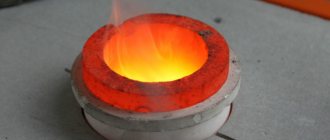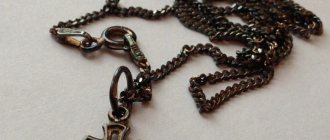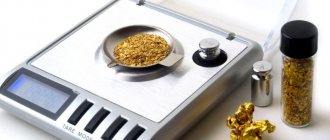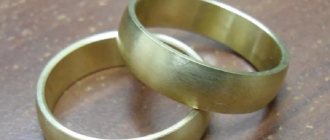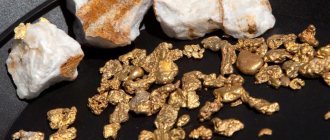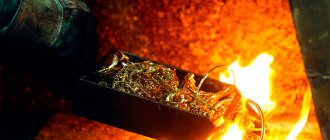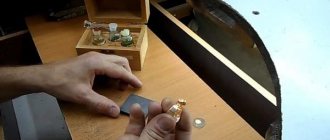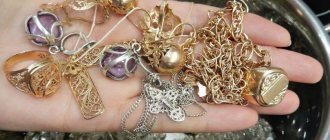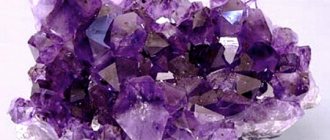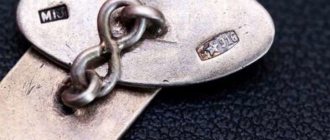Hello my readers! As a child, I thought that if you boiled my mother's ring in a saucepan, it would melt. I really wanted to see how metal melted, and I managed to conduct a dozen experiments before my mother found out that she was growing up a metallurgist. Neither experiment was successful because the melting point of gold is 1064.4 °C (degrees Celsius), and water boils at only 100 °C.
Now I have grown up and I know that everything is not so simple. But melting gold at home is still possible, although it requires more than just a saucepan and gas.
Characteristics and properties of metal
Gold is a medium-melting metal: those that melt (transition from solid to liquid) at temperatures from 600 °C to 1600 °C are considered to be such. Many metals (nickel, iron, cobalt, silver) and alloys (steel, brass, cast iron) fit the definition of medium-melting metals. Gold can be smelted using tools suitable for most metals. The boiling point of gold is 2700 °C. In addition, it has:
- high ductility and malleability;
- very high density;
- low hardness.
A bar of pure gold can be forged into thin wire without the use of high-tech equipment. With simple tools and skills, this is theoretically possible even at home, because gold is very malleable and easy to process.
Main advantage
If you think that gold is valued for its beauty, you are a little mistaken. It turns out that the gold metal is valued for its unique flexibility. When gold is exposed to high temperatures, it takes on small forms, and at low temperatures, metal particles form a massive vein. The resulting veins can be seen with the naked eye.
Jeweler's work
Plus, gold is resistant to corrosion. There are cases where gold jewelry lay in the ground for decades, and after removal it remained in its original form, without changing color or shape. The precious yellow metal is resistant to chemicals and belongs to the noble category.
How gold raw materials are processed
Before turning into an ingot, coin or jewelry, the precious metal undergoes multi-stage processing. The charge - the material to be sent to the smelting furnace - can consist of both grains of gold mined in nature and scrap (watch, jewelry, technical, dental). Preliminary manipulations are aimed at making this mixture as homogeneous as possible before melting. To do this, processing plants subject raw materials to the following procedures:
- Mechanical cleaning: crushing large pieces, grinding and sifting under running water or a solution with the addition of an abrasive, which additionally washes the mixture from dirt.
- Chemical purification from impurities - refining. Variations: amalgamation, dissolution in aqua regia or leaching - cyanidation or using theourea solutions.
- Precipitation of metal from the resulting solutions.
As a result of purification, gold is at the disposal of a factory worker (or a private jeweler) - in an amount much smaller than the original charge, but practically pure.
You can start melting.
At what temperature does it melt?
When I said 1064.4°C, I was talking about pure .999 gold. You and I can only find it in the form of bank bars (or if we engage in refining ourselves). In jewelry, industry and medicine, diluted alloyed metal is used.
The ligature is introduced into jewelry for strength, into solders - to increase fluidity and achieve the required parameters of the alloy for soldering products of each sample (color, fusibility). Here is a comparative table of temperatures at which samples with different percentage and quality content of alloy are melted:
| Color | Try | Au (gold) | Ag (silver) | Pd (palladium) | Cu (copper) | t (°C) |
| yellow | 375 | ~37.5 % | ~10 % | ~3.8 % | rest | 926–949 |
| yellow | 585 | ~58.5 % | ~8 % | No | rest | 878–905 |
| green | 585 | ~58.5 % | ~30 % | No | rest | 835–880 |
| red | 585 | ~58.5 % | No | No | rest | 907–922 |
| yellow | 750 | ~75 % | ~17 % | No | rest | 920–930 |
| pink | 750 | ~75 % | ~12.5 % | No | rest | 900–920 |
| white | 750 | ~75 % | ~5 % | ~20 % | No | 1270–1280 |
What metals are used in gold alloys, how do they change the melting point
The need to change the melting temperature of the alloy especially often arises in the manufacture of solders. More low-melting additives lower the melting point of gold:
- zinc;
- tin;
- magnesium;
- aluminum;
- silver (negligible).
More refractory metals and their alloys increase the melting point - in jewelry and industry this is mainly the platinum group:
- platinum;
- palladium;
- osmium.
Most intermetallic alloys are brittle, so they are almost never used to create jewelry, and their suitability for industrial use is limited.
Cleaning silver from alloys
Cleaning silver using nitrate
One of the common methods of purifying silver is melting using saltpeter. For this experiment you will need a crucible - a vessel that is used to heat, cook and melt various metals. A silver product is placed in the crucible, to which borax, saltpeter and soda are added. At the beginning of melting, the resulting mass actively boils due to the action of nitrate (gas is released). After the resulting composition has “calmed down,” the crucible can be removed from the forge. So what effect do the substances used have on the course of a chemical reaction? The fact is that saltpeter is capable of oxidizing base metals that make up silver, and soda and borax, when melted, can dissolve metal oxides, thereby cleaning the metal surface. As a result of chemical transformations, slag is formed in a liquid aggregate state.
Using this method of cleaning silver from unnecessary impurities, you can reduce the percentage of copper in the melt. The crucible is cooled and then broken. At its bottom you can see, above the surface of which there will be slag, which should be removed with a hammer. You just need to remember that if the silver contained a sufficiently large amount of metals and impurities, then the mass of substances used (saltpeter, soda, borax) should be greater.
If there is very little silver in stock, then it is cleaned on clay. To do this, take a piece of linden coal with a depression, which is smeared with clay and dried. Then silver and borax are placed on the clay and cleaning is carried out using a soldering iron. Saltpeter is added to the molten silver.
Cleaning silver using lead
Due to its painstaking nature, another method of cleaning using lead is less common. To do this, silver is placed in a crucible, which is covered with borax on top. The crucible is placed in the molten furnace. If the silver is melted, lead is added to it. The resulting mass is mixed, and after complete melting, it is cleaned in containers with bone ash.
Melting methods and process temperatures
Gold smelting factories have special smelting furnaces that can easily create temperatures of 1200 °C and higher. It is impossible to install one at home. Jewelers use portable melting furnaces, such as induction. Some hobbyists melt metals in microwave ovens, but it will no longer be possible to cook food in such a microwave - keep this in mind before choosing your method.
The “classic” method for private gold miners and jewelers who do not work with large volumes of raw materials is a gas or gasoline burner with an injector and a crucible - a fireproof container of suitable size.
Preparatory work
Considering that you will be working with high temperatures, you need to carefully prepare. Remove flammable items from the workplace. Make sure in advance that nothing distracts from the process. You should have protective equipment (gloves, apron) and the necessary tools (forceps and tweezers) at hand. Work clothes made of dense materials should cover the entire body. It is better to work in special glasses with elastic that fit tightly to the face. Any accidentally ejected droplet of molten metal can cause a serious burn.
You will need a fireproof dish or crucible. A crucible is a special heat-resistant container for melting. Poorly selected utensils for melting may not withstand heat or crack due to temperature changes.
This situation can be harmful to health. It is better to buy a ready-made crucible in a store.
You need to choose from the assortment one that can withstand temperatures of more than 1000 ° C. Moreover, the price of the crucible is quite reasonable. It's not worth the risk.
Is it possible to melt gold at home?
Can! But we need to prepare.
Necessary equipment and materials
To make your own castings you will need:
- melting crucible - ceramic or graphite, resistant to high temperatures;
- burner and fuel for it;
- metal tongs;
- the form into which you will pour the molten gold (mold);
- borax (sodium tetraborate, you can buy it at the pharmacy) as a flux for cleaning the melt;
- wooden or graphite stirring stick;
- access to clean water;
- auxiliary containers, napkins, protective accessories (gloves, mask).
Batch preparation
Most likely, the available raw materials can fit in the palm of your hand, so we will not imitate the factory technological process, but will simply check the scrap for the presence of unnecessary debris. If you have refined metal in your hands, then it is probably already crushed and suitable for melting - just rinse it.
If our charge is jewelry scrap, we can melt it down, but the output will not be a pure ingot, but an alloy of unknown quality (as a rule, we do not know what and in what proportions is included in the jewelry). The scrap must be thoroughly crushed before melting.
Melting process
Don't forget to wear gloves, sunglasses and be mentally prepared for the meltdown. You need to melt gold in a clean, dried crucible, sprinkling borax on both the crucible and the charge. When the mixture of borax and gold becomes homogeneous, you need to sprinkle the melt with powder a second time.
Apply the flame of the burner to the gold carefully, especially if it is in the form of small grains in the crucible, so as not to blow away any metal particles. Do not direct the flame at the gold itself: first, gently move the fire over it. Heat the crucible gradually and carefully.
The work takes from 10 minutes or more depending on the quality of the raw materials. After some time, let the gold harden slightly and look at it. If the melt becomes cloudy as it hardens, it means that the process is not over and you need to use the borax again.
When the characteristic yellow sheen stops disappearing upon cooling, melting can be considered complete.
Receiving castings
Molten gold is poured into the prepared mold. It is better if it is made of the same material as the crucible. After a few minutes, when the ingot has cooled a little, you can take it with tongs and lower it into the water.
Hallmark on 585 hallmark
The authenticity of the yellow metal must always be confirmed by a stamp indicating its purity. In Russia, this procedure is mandatory and controlled by the state. The hallmark allows the buyer to be confident in the quality and authenticity of the precious metal.
There are three branding options:
- Laser;
- Electroerosive;
- Mechanical.
The modern laser method allows you to place a mark with a high degree of readability. But the image can quickly be erased, especially if the branding site is constantly in contact with another surface. The mechanical method is still recognized as the most durable.
An example of a mark on a product and its explanation.
The mark itself consists of three parts: a letter (the hallmark code), a drawing (a woman’s head with a kokoshnik, looking to the left), and the number “585” (the hallmark itself). In addition to these symbols, a piece of jewelry may have another mark – the manufacturer’s name.
Products that are imported into Russia are also tested. In Italy and the USA there is no state standard and all responsibility for the authenticity of jewelry lies only with the manufacturer. The mark on foreign products usually consists of the symbols “14 K” (14 carats, corresponding to the domestic 585 standard) and letters indicating the manufacturer.
How to clean castings
After the borax has served its purpose and cleansed the molten gold of excess compounds, you will have to rid the ingot of the remnants of the borax itself. For final cleaning you will need:
- hydrochloric acid - 20 ml;
- nitric acid - 10 ml;
- distilled water - 0.5 l;
- fireproof flask;
- electric stove.
The casting must be boiled in an acid solution for 5 minutes and rinsed with clean water. This part of the experiment is best carried out outdoors, for example in a summer cottage: acid fumes are toxic.

